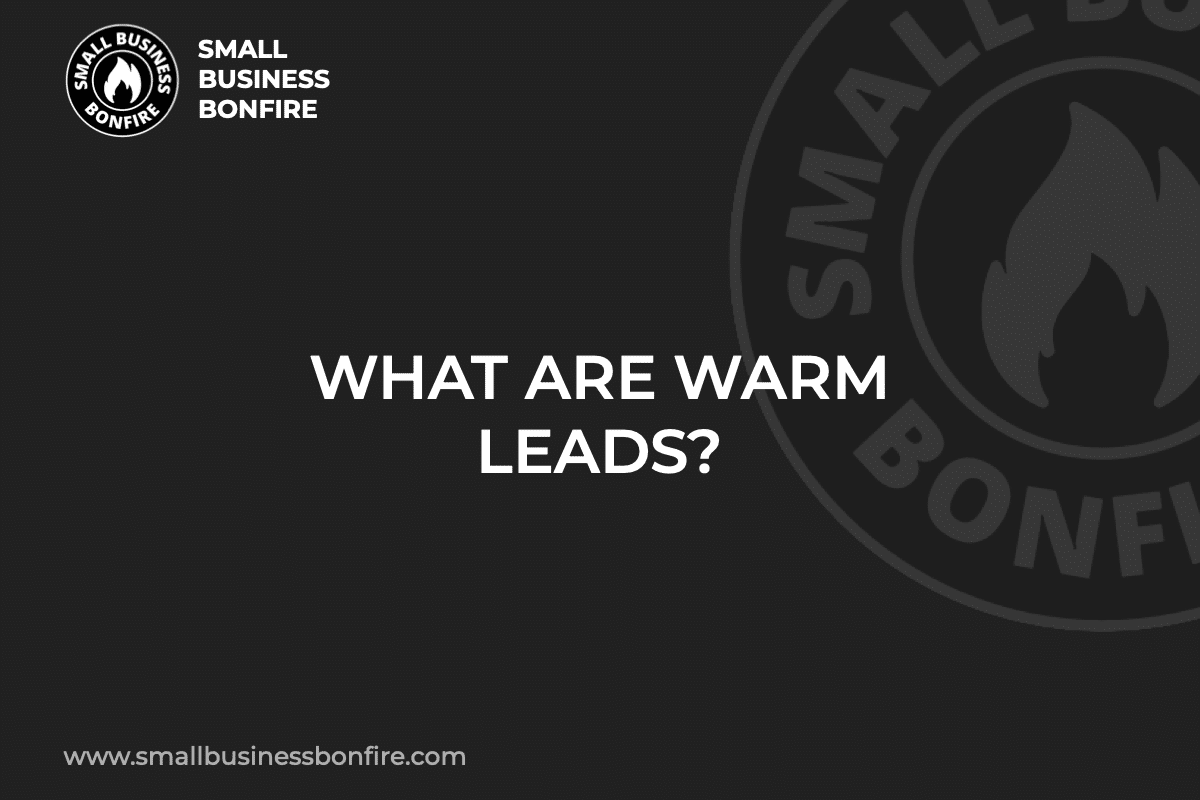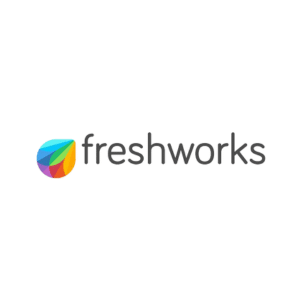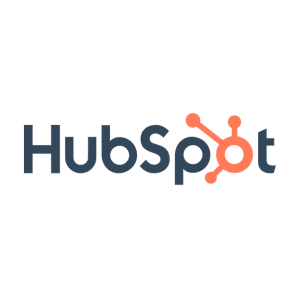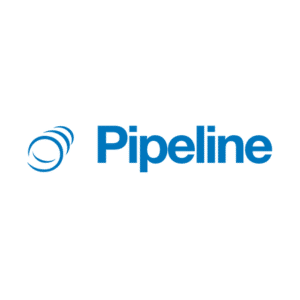Are you and your team having trouble getting those on-the-fence potential customers to actually purchase something?
Don’t worry if this sounds like you! Converting warm leads is a task several small businesses need help with!
Hi, my name’s AJ! I started Small Business Bonfire (SBB) to help other entrepreneurs scale their companies and avoid the (many) mistakes I made while building my own business.
Initially, my business’s conversion rate was scary low! However, when I learned how to nurture and convert warm leads, my company grew to incredible levels.
Keep reading if you want to learn how to do the same thing!
Key Takeaways
- Warm leads are prospects who have shown interest in your brand.
- Warm sales leads indicate interest by submitting their contact details or following social media accounts.
- The BANT framework helps teams distinguish cold, warm, and hot leads.
- You can follow up with warm leads through emails, swag boxes, and phone calls.
Related Reading: Best CRM for Small Businesses
SBB Featured Partners
What are Warm Leads?
A warm lead is a prospective buyer who has shown interest in your products or services by providing their contact details.
Warm leads know your brand’s mission, product features, etc.
Also, these leads have the financial means to purchase your products or services.
However, although these leads shared their contact information with your team, they’re not qualified enough for the sales process.
Difference Between Warm Leads and Cold Leads
The main difference between warm and cold leads primarily lies in the level of familiarity and interest a potential customer has with your business.
For instance, cold leads may not know about your business or have shown no prior interest in your product or services.
Also, cold leads haven’t interacted with your brand before, so they require more effort and time to convert due to the lack of an established relationship.
On the other hand, warm leads are those who have shown some degree of interest in your products or services by taking any of the following actions:
- Providing their contact information
- Subscribing to a newsletter
- Following your social media accounts
- Visiting your website
While they need more time to purchase, warm sales leads are already partially qualified, making the sales process more manageable.
Importance of Warm Leads
The importance of warm leads in the sales funnel cannot be understated!
For starters, warm leads significantly reduce the time and effort needed to make a sale because they are already familiar with your brand, products, and mission.
Also, a warm lead is more likely to be interested in hearing from your business, making your lead nurturing strategy more effective.
Additionally, they have a higher probability of converting into customers, improving your conversion rates.
Lastly, nurturing warm leads can build strong, loyal customer relationships, which is crucial for long-term business growth!
How to Qualify Warm Leads
The most common way to qualify cold, warm, and hot leads is through BANT.
BANT can help your sales team distinguish cold and warm leads, ensuring agents spend their time on qualified leads!
Here’s everything you need to know about BANT!
BANT
BANT is an acronym that stands for:
- Budget
- Authority
- Need
- Timeline
This framework is simple yet still an effective way to learn which prospects are warm or cold sales leads.
Budget
Does the lead you’re pursuing have the financial means to purchase your products or services?
Determining whether a prospect can afford your products is a quick way to separate warm and cold leads.
When prospects can afford your products or services, that’s an indication they’re either warm or hot leads.
Authority
The authority aspect primarily refers to buyers in a B2B (business to business) setting, where committees or groups make purchase decisions.
This criterion evaluates the degree to which the prospect influences the purchase decision.
So, if the person you’re talking with has zero purchase authority, it’s critical to contact someone who does!
Need
The need criteria ask whether the prospect has an active or ongoing problem your product or service can solve.
If the answer is yes, it’s a sign you’re talking to warm or hot leads!
Customers are much more likely to convert when your products can solve a pain point in their lives.
Timeline
Lastly, there’s the timeline aspect.
Individuals or companies that look to purchase your products soon or immediately are a sign of warm leads.
Remember, some customers are planners and may want to gather information and compare between various companies.
So, if someone is still waiting to buy but meets the rest of the BANT criteria, you can label them as a warm sales lead!
How to Generate Warm Leads
Generating warm leads can be challenging.
However, with the strategies I’ve listed below, your team can generate more warm leads!
Lead Magnets
A lead magnet is a valuable resource or benefit businesses offer potential customers in exchange for their contact information.
These can take various forms:
- eBooks
- Whitepapers
- Discount codes
- Free trials
Also, a lead magnet incentivizes the initial engagement and facilitates converting from a cold lead to a warm one.
Live Chat
Live chats are beneficial because they provide immediate, real-time engagement with potential customers.
Further, live chats do the following things:
- Humanize the brand
- Create a positive customer experience
- Provide excellent customer service
Contact Forms
Contact forms are interactive tools that enable visitors to leave their contact information.
Contact forms are essential for the sales cycle because they do the following things:
- Provide an efficient way to capture lead information
- Initiate first contact
- Open communication channels
These forms are an effective strategy to generate warm leads!
Social Media
Social media platforms are an excellent way to turn cold leads into warm ones.
Also, with social media, you can reach a broad audience for free!
Carefully note the individuals who interact with your accounts most often because this indicates they resonate with your brand.
Referrals
Referral programs are crucial in generating warm leads as they leverage your existing customer base to bring in new prospects.
This cost-effective method holds high conversion potential because referrals come from trusted sources.
As a result, this fosters a sense of credibility and trust right from the start!
Industry Events
Industry events, such as conferences, are excellent platforms to generate warm leads because they attract an audience already interested in your industry.
By showcasing your products or services and interacting directly with potential customers at these events, you can pique their interest and pull them out of the cold lead stage!
Trade Shows
Trade shows allow businesses to display their products or services directly to a large audience of industry professionals and potential customers!
This face-to-face interaction can do the following things:
- Foster relationships
- Increase brand awareness
- Accelerate the conversion of cold leads into warm ones
Networking
Networking creates opportunities to build relationships and engage directly with potential customers, warming up cold leads!
This interaction enables businesses to do the following things:
- Demonstrate their value proposition
- Foster trust
- Better understand your prospects’ needs
While networking, ensure you send personable employees to the events!
How to Convert Warm Leads
Now that you know how to generate warm leads, it’s time to learn how to convert them.
Utilize these strategies to close warm leads and earn more sales!
Perform Effective Outreach
Effective outreach is all about personalized and timely communication.
Companies can achieve this by researching their warm leads thoroughly to understand their needs, preferences, and pain points.
After that, it’s crucial to craft tailored messages that resonate with these sales leads, delivered at the right time via the most appropriate channels!
Get the Right Leads
To get the best leads, companies must clearly define their target audience.
Understanding your ideal customers means learning how their:
- Demographics
- Behavior
- Needs
- Motivations
Then, leveraging this knowledge, you should utilize targeted marketing strategies.
Some practical marketing efforts include:
- Content marketing
- SEO
- Social media marketing
- Email campaigns
Utilizing marketing channels to create personalized messaging, your team can find more hot leads!
Establish a Lead Nurturing Framework
Creating a lead nurturing framework involves establishing a systematic process that engages warm leads at each stage of the buyer’s journey.
On top of that, it’s crucial to provide these sales leads with relevant content and maintain consistent communication.
An excellent way to deliver relevant content is through customer segmentation.
Segmenting customers by behaviors and interests makes it easier to separate hot leads from cold ones.
Offer Free Trails
Offering free trials is a powerful way to convert warm leads because it allows potential customers to experience your product or service first-hand!
As a result, this eliminates any apprehensions cold sales leads may have about your product’s efficacy.
Further, free trials introduce users to the benefits of your offerings, which can strongly motivate them to shift from trial users to paying customers!
Get Personal
Lastly, creating personalized communication efforts is an excellent strategy for generating warm sales leads.
A personalized buying experience ensures potential buyers feel special and like you’re tailoring the process to their specific needs!
Also, getting personal promotes the following things:
- Higher customer satisfaction levels
- More customer retention
- More customer loyalty
How to Follow Up with Warm Leads
One trick to convert warm prospects to hot leads is following up with them.
Here are five ways to follow up with sales leads!
Follow Up Emails
A follow-up email should include a brief reminder of your initial interaction.
Also, ensure you highlight the critical points of your product and the potential value or benefits it can provide!
On top of that, these messages should extend an invitation for further interaction or a call to action, such as:
- Scheduling a follow-up call
- Offering a demo
- Asking for feedback
Follow Up Calls
Follow-up calls are beneficial because they establish a direct, personal connection with warm leads.
These calls allow you to do the following things:
- Address prospect queries
- Clarify information
- Demonstrate your commitment to their needs
More importantly, these calls can provide insightful feedback about your leads, helping you tailor sales approaches.
Mailers
Physical mail is an effective way to follow up with sales leads because they can’t ignore the message!
When making these mailers, ensure they’re visually appealing and contain the most essential information about your products or services.
Swag Boxes
Swag boxes, filled with company-branded goodies, serve as a practical, tangible reminder of your business.
Therefore, these gifts help to keep your brand at the forefront of a warm lead’s mind.
These personalized gifts can enhance the relationship and instill a sense of loyalty.
Throwing an Event
Lastly, hosting an event is a perfect way to encourage leads to convert into paying customers.
Events help you meet your target audience face to face, building stronger relationships.
During these events, it’s crucial to connect with potential buyers individually to help them feel seen!
How Often to Follow Up with Warm Leads
When is a good time to follow up with warm leads?
You don’t want to seem too pushy, but you don’t want this potential buyer to slip through your fingers!
Here’s a practical way to determine when to follow up with these leads.
Determine How Long They’ve Been Warm
The first step is determining how long a warm lead has been warm.
For instance, if the lead has been warm for a while, your team can follow up with them less often.
On the other hand, prospects you recently labeled as warm demand quicker follow-ups because they have a higher chance of converting to hot sales leads.
Provide Value with Each Follow-Up
Every interaction with your warm leads should be an opportunity to offer them value and build their trust.
Your team can do this through the following methods:
- Sharing relevant industry insights
- Offering expert advice
- Providing solutions to their perceived challenges
By doing these things, you keep your leads engaged and nudge them closer to becoming hot sales leads!
How to Warm Up Cold Leads
The final topic I’ll cover is strategies to warm up cold leads.
Typically, I recommend the three-step process listed below!
Step 1: Understand Your Customer’s Pain Points
Understanding your customer’s pain points is crucial because it helps tailor your products or services to meet their needs.
Some actions you can take to understand your audience’s pain points better include the following:
- Conduct thorough market research
- Engage in active listening during interactions
- Utilize feedback surveys to gather insights
Step 2: Show the Value of Your Product or Service
Companies can showcase the value of their products or services by articulating their unique selling propositions, demonstrating how they solve customer pain points more effectively than their competitors.
Also, customer testimonials and case studies can demonstrate real-world examples of how these products have positively impacted others!
Step 3: Nurture Cold Leads Into Warm Leads
Lastly, it’s crucial to have a lead nurturing process to convert cold leads.
Lead nurturing helps potential buyers feel special and helps them understand that your company genuinely cares about them!
Final Thoughts on Warm Leads
Warm leads are people who have shown interest in your brand.
Typically, these leads show this subtle interest by submitting their contact information or following your business on social media.
Nurturing and converting warm leads can be done through in-person events, email marketing, and phone calls.
Now that you know all there is to know about warm leads, it’s time to implement this information into your business!
Newsletter Signup
Join The Leads Field Guide Newsletter for tips, strategies and (free) resources for growing your leads, and closing more deals.




